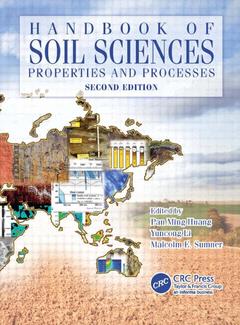Handbook of Soil Sciences (2nd Ed.) Properties and Processes, Second Edition Handbook of Soil Science Series
Coordonnateurs : Huang Pan Ming, Li Yuncong, Sumner Malcolm E.

An evolving, living organic/inorganic covering, soil is in dynamic equilibrium with the atmosphere above, the biosphere within, and the geology below. It acts as an anchor for roots, a purveyor of water and nutrients, a residence for a vast community of microorganisms and animals, a sanitizer of the environment, and a source of raw materials for construction and manufacturing. To develop lasting solutions to the challenges of balanced use and stewardship of the Earth, we require a fundamental understanding of soil?from its elastic, porous three-phase system to its components, processes, and reactions.
Handbook of Soil Sciences: Properties and Processes, Second Edition is the first of two volumes that form a comprehensive reference on the discipline of soil science. Completely revised and updated to reflect the current state of knowledge, this volume covers the traditional areas of soil science: soil physics, soil chemistry, soil mineralogy, soil biology and biochemistry, and pedology. Contributors discuss the application of physical principles to characterize the soil system and mass and energy transport processes within the critical zone. They present significant advances in soil chemistry; describe how minerals are formed and transformed; and provide an introduction to the soil biota. They also examine geomorphology, land use, hydropedology, and subaqueous soils as well as the classification and digital mapping of soil.
Critical elements addressed in each section include:
- Descriptions of concepts and theories
- Definitions, approaches, methodologies, and procedures
- Data in tabular and figure format
- Extensive references
This cohesive handbook provides a thorough understanding of soil science principles and practices based on a rigorous, complete, and up-to-date treatment of the subject matter compiled by leading scientists. It is a resource rich in data, offering professional soil scientists, agronomists, engineers, ecologists, biologists, naturalists, and students their first point of entry into a particular aspect of the soil sciences.
Soil Physics. Soil Chemistry. Soil Mineralogy. Soil Biology and Biochemistry: Soil Biology in Its Second Golden Age. Pedology. Index.
Dr. Pan Ming Huang was the professor of soil science emeritus at the University of Saskatchewan, Saskatoon, Saskatchewan, Canada, and served for 44 years in that institution. His research work has significantly advanced the frontiers of knowledge on the formation chemistry, nature, and surface reactivity of mineral colloids, organic matter, and organomineral complexes in soils and sediments and their role in the dynamics, transformations, and fate of nutrients, toxic metals, and xenobiotics in terrestrial and aquatic environments. His research findings, embodied in well over 300 refereed scientific publications, are fundamental to the development of sound strategies for managing land and water resources in the Earth’s critical zone.
Dr. Yuncong Li is the University of Florida Research Foundation (UFRF) professor of soil science in the Department of Soil and Water Science at the Tropical Research and Education Center, Institute of Food and Agricultural Sciences (IFAS), University of Florida in Homestead. He is also an affiliated professor at the University of Florida’s Center for Tropical Agriculture, Hydrologic Sciences Academic Cluster, School of Natural Resources and Environment, and Water Institute. His research and extension program focuses on water and soil quality monitoring, assessment and remediation, management practices to improve nutrient use efficiency, and nutrient cycling in soils/sediments. He has authored or coauthored over 150 research papers, 70 extension articles, and 15 book chapters. He recently edited a book, Water Quality Concepts, Sampling, and Analyses (CRC Press, 2010). He serves as an associate editor for Critical Reviews in Environmental Science and Technology and Communications in Soil Science and Plant Analysis.
Dr. Malcolm E. Sumner is the Regents’ Professor of Environmental So
Date de parution : 12-2011
Ouvrage de 1442 p.
21x28 cm
